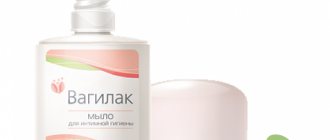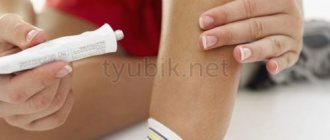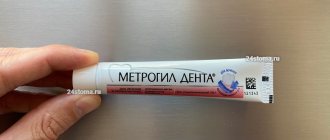Vagilak intimate hygiene gel moisturizing 50 g
Compound
Purified water, propylene glycol, hydroxyethylcellulose, potassium sorbate, lactic acid.
Application area
Dryness of the mucous membranes of the vagina and vulva is a problem that worries many women of all ages. The number of women who face this problem is constantly growing.
Dry mucous membranes can lead to the appearance of microcracks, discomfort, burning and pain in the intimate area, especially during sexual intercourse, which sharply reduces the quality of life.
Insufficient vaginal moisture can be due to a number of reasons:
• the period of menopause, when the amount of female sex hormones is reduced (a common condition in older postmenopausal women);
• taking certain medications, including constant use of hormonal contraceptives;
• use of antibiotics and antifungal drugs;
• chronic diseases (for example, hypothyroidism, diabetes mellitus);
• conditions after gynecological operations;
• physical and psychological stress;
• stress;
• fatigue, dissatisfaction.
Moisturizing gel for intimate hygiene Vagilak allows you to quickly and effectively eliminate dry mucous membranes and improve the quality of sexual life. The gel replenishes the lack of natural lubrication, eliminates the feeling of discomfort caused by dryness, and provides long-lasting and optimal hydration of the genital mucosa. It has a gentle and safe effect on the mucous membrane, prevents its damage and promotes regeneration processes. Lactic acid, which is part of the gel, helps maintain optimal pH levels and preserve the natural microflora of the intimate area.
Properties
• Quickly eliminates dryness in the intimate area;
• Has a long-lasting moisturizing effect in the intimate area;
• Contains lactic acid, necessary to maintain the natural pH level and vaginal microflora;
• Quickly absorbed, does not leave stains on clothes;
• Compatible with latex, does not contain substances that destroy it;
• Does not contain perfumed fragrances or fatty oils;
• Can be used for daily intimate hygiene.
Indications for use
• conditions accompanied by dryness of the mucous membranes of the female genital tract, especially during peri- and postmenopause;
• as an additional remedy in the complex correction of inflammatory and dysbiotic gynecological diseases;
• after taking antibacterial, antifungal drugs;
• against the background of constant use of hormonal contraceptives;
• daily intimate hygiene;
• prevention of mucosal trauma when performing diagnostic gynecological procedures.
Mode of application
Squeeze a small amount of Vagilak gel onto a clean finger and apply to the intimate area. Use the included applicator to apply the gel deeper into the vagina. To fill the applicator, place it on the opening of the tube and squeeze out a small amount of gel. Detach the applicator from the tube, insert it into the vagina and squeeze out the gel. The applicator can be used an unlimited number of times. After use, rinse the applicator in warm water, dry thoroughly and store in a dry place. The gel can be applied in a thin layer to the penis or the outer surface of a condom, and can also be used to facilitate insertion of rectal thermometers and enemas.
Side effects
The components of the gel, when applied topically, do not have a systemic effect on the body. Sometimes allergic reactions are possible.
Contraindications
Individual intolerance to components.
special instructions
Moisturizing gel for intimate hygiene Vagilak is not a contraceptive!
Release form
50 g of gel in a tube with an applicator.
Functional characteristics and purpose
General information:
Vaginal dryness and a feeling of discomfort in it are observed quite often; more than half of women experience these unpleasant sensations, regardless of age and living conditions. Due to hormonal changes, women especially often face this problem during and after menopause. Normally, the walls of the vagina are lubricated in the form of a thin layer of clear liquid. During menopause, a decrease in estrogen levels leads to a decrease in the amount of this lubricant. In addition, the vaginal tissue becomes thinner and less elastic. This is another of the most common reasons for discomfort in all sexually active women. Many women first notice vaginal dryness due to the fact that they experience discomfort and even pain during intercourse. This undermines their self-confidence, spoils their mood and interferes with normal daily activities, causing a general feeling of discomfort.
Causes of vaginal dryness:
The most common cause is a decrease in the natural production of vaginal lubrication due to hormonal changes in a woman's body, for example, in the second half of the menstrual cycle or in connection with menopause. But there are many other factors that can also cause this problem or increase its severity, namely: the use of hormonal contraceptives or the use of certain medications, soaps or tampons, stress, fatigue, pregnancy, childbirth, as well as sexual intercourse without proper natural lubricating the vagina with fluid produced by the body itself, or with appropriate means, for example, Multi-Gyn® LiquiGel.
Release form
Aluminum tube 30 ml with a special applicator with a small cap for internal use, with instructions for use in a cardboard pack.
Multi-Gyn® LiquiGel is a non-sterile product.
In medical institutions and at home, additional sterilization or disinfection procedures are not required before its initial and subsequent use.
Conditions for storage and operation (use) of a medical device
It is recommended to store Multi-Gyn® LiquiGel out of the reach of children and away from light at temperatures from + 0° to + 25° C and relative humidity from 6° to 8°%. Avoid freezing. Operation (use) of the product is allowed at nominal temperatures from +320 to +42°C and relative humidity from 40% to 8o%. Before using the product, make sure there are no obvious signs of damage to the packaging.
Conditions for transporting a medical device
All types of covered transport in accordance with the rules for the transportation of goods in force for each type of transport. Transportation of a medical device is allowed at temperatures from +10° to +25°C and relative humidity from 6o% to 8o%. Avoid freezing.
Best before date
3 years. Do not use after expiration date. After initial opening, the product is recommended to be used within 3 months. Manufacturer's warranty The manufacturer guarantees the quality of the medical device until its expiration date, provided that its packaging is not damaged and all conditions for storage and transportation of the product are met.
Requirements for maintenance and repair of a medical device
Multi-Gyn® LiquiGel is not subject to maintenance or repair.
The procedure for recycling and destruction
At home, unused (expired) products and used products must be disposed of together with household waste. In medical and/or pharmaceutical organizations, the disposal of unused (expired) products and used products is carried out in accordance with the requirements/rules of the buyer’s country. On the territory of the Russian Federation, according to the degree of danger, in accordance with SanPiN 2.1.7.2790-10, the product belongs to class A - epidemiologically safe waste and must be disposed of together with household waste.
Bacterial vaginosis is a common vaginal infection that occurs in 20% of women of reproductive age [1]. Despite the fact that bacterial vaginosis occurs mainly in a mild form, and in some cases occurs without symptoms, it can lead to endometritis and other inflammatory diseases of the pelvic organs [2, 3]. In the presence of bacterial vaginosis, pregnancy complications such as spontaneous abortion, chorioamnionitis, premature rupture of amniotic fluid, premature birth and postpartum endometritis can occur [4, 5]. In women in the IVF program, bacterial vaginosis reduces the implantation rate and can also cause intrapartum fetal death [6, 7]. The main pathological process characteristic of this disease is the excessive growth of anaerobic microorganisms such as Gardnerella vaginalis, Mycoplasma hominis
and
Mobyluncus
. This leads to an increase in pH in the vagina and the appearance of discharge with an unpleasant odor. The normal microflora of the vagina consists mainly of lactobacilli, which prevent the spread of the above pathogens. Lactobacilli produce lactic acid, which acidifies the vaginal contents [8], as well as hydrogen peroxide, which has a toxic effect on other microorganisms [9, 10].
In the treatment of bacterial vaginosis, metronidazole is most often used, which does not affect lactobacilli, but has a negative effect on anaerobic microorganisms. Clindamycin is also widely used [11, 12]. Although these drugs are considered safe, they may cause unwanted side effects. When using metronidazole, gastrointestinal disorders such as nausea and vomiting may occur, and less commonly, a metallic taste in the mouth, paresthesia and leukopenia may occur [13]. The most common adverse events with clindamycin include rash and gastrointestinal problems such as anorexia, abdominal pain, nausea, vomiting and diarrhea. The latter can also be a symptom of pseudomembranous enterocolitis. Less common adverse events include neutropenia, leukopenia, jaundice, and skeletal muscle paralysis [14]. Both drugs can be taken orally as well as vaginally. In 10-15% of women, initial antimicrobial therapy is not effective. Among patients who respond well to treatment, 69% develop relapses of bacterial vaginosis within 1 year, which leads to the need for repeated antibiotics [15].
The high rate of relapses, despite antimicrobial therapy, led to the search for alternative treatment methods that could be prescribed in conjunction with already used drugs or as monotherapy. The predominance of lactobacilli in the normal vaginal microflora and their absence in bacterial vaginosis has stimulated the use of various types of lactobacilli both orally and vaginally in order to restore the vaginal microflora [16]. These medications are also known as probiotics and are live microorganisms that, when taken in the right dosage, can improve vaginal health [17]. It is also known that some strains of lactobacilli can spread into the vagina after oral or vaginal administration [18]. In addition, lactobacilli can be used for a long time without the risk of developing dangerous adverse events, which makes them an attractive alternative to antimicrobial therapy, especially given the risk of relapse [19, 20].
The purpose of this study was to evaluate the effectiveness of the oral probiotic Vagilak (Rijeka, Croatia) compared with placebo in women with bacterial vaginosis who do not suffer from any other diseases. Our hypothesis was that the percentage of restoration of normal vaginal microflora would be significantly higher in women taking probiotics compared to those taking placebo.
Material and methods
The study was planned as a randomized, double-blind, multicenter, placebo-controlled study. The study protocol was approved by the Ethics Committee of the University of Zagreb Medical School. Study participants were recruited from 55 primary care obstetric and gynecological care providers in central and northwestern Croatia. The study included women over the age of 18 years who were diagnosed with a vaginal infection (bacterial vaginosis, candidiasis, trichomoniasis, or a combination of these). Exclusion criteria include pregnancy, breastfeeding, menstruation, and the woman's unwillingness to give informed consent to participate in the study.
The initial (initial) diagnosis of bacterial vaginosis was made taking into account the Amsel criteria or the Nugent index. In routine clinical practice in Croatia, bacterial vaginosis is most often diagnosed based on the Amsel criteria [21], which include the presence of a thick grayish vaginal discharge, a pH level >4.5, the appearance of a special odor after adding potassium hydroxide to the discharge and the presence of so-called “ key cells" in a wet saline preparation. To confirm the diagnosis of bacterial vaginosis, at least three of these four criteria must be present.
However, some specialists more often use a method based on the Nugent index [22]. In such cases, vaginal smears are Gram-stained and scored using a 10-point scale, counting the total number of Lactobacilli, such as G. vaginalis
and
Mobiluncus
available in the field of view during microscopic examination. The initial diagnosis of vulvovaginal candidiasis and trichomoniasis was made using conventional diagnostic tests. If one of the above-mentioned diagnoses was made during the initial screening examination, additional smears were taken to confirm the diagnosis at the central laboratory.
After obtaining informed consent, all patients included in the study were divided into two groups, one of which took a placebo and the other took a probiotic. The randomization process was carried out using a computerized randomization list, which assigned each study participant to either group A or group B. Randomization lists were created using the software and methodology described by M. Saghaei [23]. Then the study participants took the necessary drug - 2 capsules of Vagilac (each containing >109 CFU of Lactobacillus rhamnosus
GR-1 and
L. reuteri
RC-14) or 2 identical placebo capsules per day for 6 weeks.
At 6 and 12 weeks after the start of the study, all study participants underwent two additional gynecological examinations. In patients with bacterial vaginosis, vaginal smears were assessed using the procedure that was used during the initial selection of study participants. If vulvovaginal candidiasis was present, assessment was performed using vaginal pH and 10% KOH wet mount testing. All patients with trichomoniasis took a single dose of 2 g of metronidazole orally. In addition, all study participants had vaginal smears examined by a clinical cytologist, and the process of culturing Lactobacillus
on agar plates.
Cultivation of Lactobacillus
was carried out using the method [24].
After treating individual cells in sterile phosphate-buffered saline (PBS), the solutions were plated on agar plates with or without tetracycline (50 μg/ml). After incubation, the plates were analyzed visually, Gram stained, and also examined for the presence of a catalase reaction. After this procedure, pale yellow, tetracycline-resistant, gram-positive bacterial colonies without catalase reaction were classified as Lactobacillus
spp.
The primary outcome of the study was the rate of restoration of normal vaginal microflora at the end of the 6-week follow-up period. Moreover, we monitored the recurrence rate of bacterial vaginosis after 6 weeks during which study participants were not taking the study drug. The sample size was calculated such that significant statistical significance could be achieved ( β
≥0.90) with a relatively low probability of type-1 errors (
α
<0.05). NCSS PASS software [25] was used with the null hypothesis of achieving a 40% cure rate in the placebo group compared with a 65% cure rate in the probiotic group. The null hypothesis was based on previous experience with the probiotic preparation. This assumption resulted in a sample size of 120 participants in each group. However, 544 women were ultimately included in the study.
All statistical analyzes were performed using Statistica software (version 9, , Tulsa, OK, USA). Percentages and proportions were calculated for categorical data, and medians and ranges were calculated for continuous data. Differences in continuous variables were analyzed using the Student's t test (with normal distribution) or the Mann-Whitney U test (with non-normal distribution). Normality of distribution was checked using the Shapiro-Wilk test. For categorical variables, differences were analyzed using the &khgr;2 test. All obtained p
are two-sided.
p
value <0.05 indicated statistical significance.
results
Over a 12-month period (March 2008–March 2009), 544 women were included in the study. Detailed information about inclusion in the study is presented in the figure.
.
Figure 1. Study inclusion flowchart. Study participants were randomly divided into two groups: a placebo group ( n
=149; 27.39%) and a probiotic group (
n
=395; 72.61%).
After recruiting the minimum required number of patients in the placebo group, the most effective way to achieve statistical significance without withholding treatment from patients with bacterial vaginosis was to increase the number of subjects in the probiotic group. At the initial visit, patients in the two groups had similar demographic parameters: age, number of children, number of sexual partners, age of first sexual intercourse, bad habits (smoking and drinking alcohol), marital status and contraceptive method used (Table 1)
.
In addition, the results of cytological smears were similar in patients of both groups (
p
= 0.149)
(Table 2)
.
The mean follow-up period was 44.16 days, i.e. approximately 6 weeks and 2 days, and was similar in both groups ( p
=0.733).
During the follow-up period, study participants took either placebo capsules or probiotic capsules twice daily, as described above. Patient adherence to treatment was similar in both groups (97.64% in the placebo group and 91.67% in the probiotic group; p
= 0.128).
After the above-mentioned follow-up period, restoration of normal vaginal microflora was observed in 40 (26.85%) study participants in the placebo group and in 243 (61.52%) in the probiotic group. Differences between groups are statistically significant ( p
<0.001). During this period, the number in need of treatment (NNT) was 2.9 with a relative risk reduction (RRR) of 47.4%.
After 6 weeks of observation, the normal state of vaginal microflora remained in more than half (51.14%) of women in the probiotic group and only in ⅕ (20.81%) of patients in the placebo group ( p
<0.001).
In this later period, the NNL rate was 3.3, while the TSR rate was 38.3%. Detailed information about the results of cytological smears is given in Table.
3 .
All study participants with negative results at the second visit (12 weeks) subsequently received the necessary treatment after their participation in the study was completed.
Additional cultivation on agar plates was carried out for the purpose of recovery and identification of lactobacilli in vaginal smears. Increased concentrations (>105 CFU/ml) of lactobacilli were observed in 81.5% of women taking the probiotic, compared with 28.9% of women taking placebo. Thus, the restoration of normal (balanced) vaginal microflora was accompanied by the presence of a large amount ( p
<0.001) lactobacilli in vaginal smears during the last two visits.
None of the demographic indicators given in table. 1
, did not have a significant impact on the results - the number of patients with restored normal vaginal microflora 6 and 12 weeks after measuring the initial indicators.
However, borderline significance ( p
=0.082) was found when comparing the number of children born. Women who gave birth to 3 or more children were less likely to experience restoration of normal vaginal microflora compared to women who gave birth to 2 children, 1 child, or nulliparous women. These results are apparently not due to the older age of women who gave birth to more children (40.1 years for women with 3 children or more vs. 29.9 years for women with 2 children or fewer), since age did not influence the results , as discussed above. One explanation may be the fact that the occurrence and recurrence of bacterial vaginosis (and other infections of the female genital tract) are more common in women who have given birth to more children, as has already been proven by other researchers [26]. However, a larger study with a longer follow-up period is needed to confirm or reject this hypothesis.
Discussion
Bacterial vaginosis is a condition associated with low levels of Lactobacillus
spp. in the vagina [27]. Although the source of vaginosis (re-infection or relapse) has not been fully determined, it is believed that lactobacilli, through the production of lactic acid, slow down the growth of other microorganisms, which leads to inhibition of their excessive growth [20, 28]. The same mechanism is responsible for maintaining low pH levels. The most commonly used strains of lactobacilli in the treatment process are a combination
L. rhamnosus
GR-1 and
Lactobacillus fermentum
in vitro
studies demonstrated the ability to adhere to vaginal epithelial cells [29]. Because of this, they can spread into the vagina after oral administration of drugs [13].
Studies examining the effectiveness of probiotics in the treatment of bacterial vaginosis are rare. K. Anukam et al. [24] conducted a randomized, controlled, double-blind study that confirmed the positive results of the combined use of metronidazole and an oral probiotic compared with placebo in the treatment of bacterial vaginosis. After a 30-day period, 88% of patients taking probiotics had no signs of bacterial vaginosis, compared with 40% of those in the placebo group ( p
<0.001). The same authors conducted another randomized clinical trial examining the comparative effectiveness of intravaginal probiotics used in conjunction with metronidazole gel for the treatment of bacterial vaginosis [30]. During this study, similar results were obtained. Similar results were published by R. Martinez et al. [31] (combined use of tinidazole and probiotics compared with tinidazole and placebo) and W. Ya et al. [28], who recently conducted a randomized, double-blind, placebo-controlled trial examining the effectiveness of an intravaginal probiotic for the prevention of recurrent bacterial vaginosis.
Despite a number of shortcomings regarding the number of participants, inclusion criteria or methods used during follow-up, the above-mentioned studies provide significant evidence of the effectiveness of Lactobacilli
in the treatment of bacterial vaginosis.
Taking this fact into account, we planned to include a fairly large number of patients in our study. In addition, we carefully developed a diagnostic procedure both at baseline and during follow-up, and closely monitored patient compliance with treatment. Using this study design, we were able to study the condition of a sufficiently large number of patients during a specific period and avoid errors typical of single-center studies [32]. Finally, by recruiting study participants from the general population and testing treatment effectiveness in a variety of clinical situations, we have provided an experimental setting that is more representative of the future. The main limitation of the study was the relatively short follow-up period of 6–12 weeks, but we thereby avoided loss of contact with study participants. In addition, DNA testing for Lactobacillus
GR-1 and RC-14 would have facilitated the identification of strains in vaginal swabs taken during the follow-up period, but this was not possible during the study period.
Our results confirm the effectiveness of an oral probiotic as previously demonstrated. These results also demonstrate an association between the number of women with increasing numbers of Lactobacillus
spp. after treatment and the number of patients with restoration of balanced vaginal microflora, which was the main outcome of the study. In our opinion, the most important result of probiotic therapy in general (both intravaginal and oral) is the ability to reduce the concentration or completely eliminate metronidazole in the treatment of bacterial vaginosis. The intravaginal probiotic has already been proven to be more effective than metronidazole in the treatment of this disease [33], and our results confirm the similar effectiveness of the oral probiotic Vagilac. In our opinion, oral probiotics are an alternative treatment for common gynecological diseases, devoid of adverse effects, which makes it possible to combine them with both metronidazole and probiotics in vaginal capsules. We agree with W. Ya et al. [28], who believe that the potential effectiveness of probiotics compared to antibiotics should be confirmed in further randomized clinical trials.
Conclusion
Oral probiotics, such as Vagilak, are an alternative treatment for bacterial vaginosis with high efficacy and safety, which allows it to be combined with both metronidazole and intravaginal probiotics.
Vagilak capsules No. 15
Name
Vagilac caps. No. 15
Description
Oral probiotic to restore vaginal microflora.
Main active ingredient
dietary supplement
Release form
Capsules
Dosage
15 capsules
pharmachologic effect
Vagilac helps increase the number of lactobacilli in the vagina and normalizes vaginal microflora. The bacteria Lactobacillus rhamnosus GR-1™ and Lactobacillus reuteri RC-14™ restore the natural acidic environment in the vagina (pH 3.8-4.5) and increase the resistance of the mucosa to pathogenic microorganisms.
Indications for use
- Vaginal dysbiosis, including bacterial vaginosis, as an independent remedy or in complex therapy;
- During and after therapy with antibiotics, cytostatics, corticosteroids, antifungal and antiviral drugs;
- Subacute and chronic inflammatory processes of the female genital area;
- During and after specific antimicrobial, antiviral and immunomodulatory therapy for urogenital infections and sexually transmitted diseases (gonorrhea, chlamydia, urogenital herpes, human papillomavirus infection, etc.);
- Prenatal preparation of pregnant women;
- Preparation for planned diagnostic and therapeutic gynecological operations;
- When using contraception (IUD, COC, spermicides);
- Hormone-dependent colpitis, senile, etc., as an independent remedy or against the background of specific hormonal therapy.
Directions for use and doses
To normalize microflora, it is recommended to take 1 capsule per day. For complex therapy of chronic inflammatory diseases of the genital organs, as well as during and after treatment with antibiotics, it is recommended to take 2 capsules per day. When taking oral antibiotic therapy, Vagilak is taken at least 2 hours before or after taking antibiotics. Capsules should be taken during meals with water. Improvements in the quality of vaginal flora should be expected within two weeks when using 1 capsule per day, but no later than after 4-6 weeks.
Contraindications
Hypersensitivity to the components of Vagilac.
Compound
1 caps. contains probiotic strains of bacteria Lactobacillus rhamnosus GR-1™ and Lactobacillus reuteri RC-14™ in a total amount of at least 109 live bacteria. Excipients: dextrose, starch, microcrystalline cellulose, magnesium stearate;
Storage conditions
In a place protected from light, at a temperature not exceeding 25 °C.






